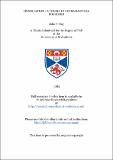Files in this item
Humiliation : a theme in ecclesiastical folklore
Item metadata
| dc.contributor.advisor | Gifford, Douglas | |
| dc.contributor.author | Guy, John Purchase | |
| dc.coverage.spatial | 132 p. | en_US |
| dc.date.accessioned | 2018-07-13T15:00:40Z | |
| dc.date.available | 2018-07-13T15:00:40Z | |
| dc.date.issued | 1983 | |
| dc.identifier.uri | https://hdl.handle.net/10023/15390 | |
| dc.description.abstract | This work is an investigation into the background of a phemomenon found in the field of folklore, namely, public shame. In particular, the Spanish Inquisition provides the context for an enquiry into why a people accepted the humiliation of its fellows in the name of religion. The main quarry of the Inquisition were apostate Jews, who, after forcible conversions to Christianity, were spied on and betrayed whenever the slightest deviation from Catholic dogma was perceived. Contrition, expressed by public exhibition in an auto-de-fe or by burning, was held to be Penance. The enquiry shows the development of public penance from the appearance of Jewish monotheism through to the first centuries of Christianity (Chapter II). In the Christian era, penance was a voluntary act of self-humiliation, but later innovations from the Celtic Church modified its stringencies. Meanwhile the Spanish Church maintained the older, harsher forms (Chapter III). The Papal Inquisition of 1232 insisted on public penance by the wearing of "crosses", and its whole machinery of inquisition passed to the Spanish Inquisition (Chapter IV). Then, the Jewish persecution by the Spanish Church from 303 to 1480 is traced. Forcible conversion of Jews in 1391 split Spanish society into Old Christians and New, from which grew the problem of heresy (apostasy). By 1478 converso Jews held important positions in Church and State (Appendix A), and the Church thought it saw, through apostates, a threat to both the purity of the Faith and to Spanish sovereignty. Reacting to heresy, the Inquisition carried its penalties to such extremes as to suggest that its chief motivation was fear (Chapter V) . Chapters VI and VII set out the extent of the public humiliation of accused persons: Chapter VIII deals with the strong correspondence between the components of a "craze" such as the witchhunts of sixteenth and seventeenth century Europe, and the principal elements of the Inquisition. The origins of both seem to lie in the realm of imaginary fear and hatred. | en_US |
| dc.language.iso | en | en_US |
| dc.publisher | University of St Andrews | |
| dc.subject.lcc | GR230.G9 | en |
| dc.subject.lcsh | Folklore—Spain | en |
| dc.title | Humiliation : a theme in ecclesiastical folklore | en_US |
| dc.type | Thesis | en_US |
| dc.type.qualificationlevel | Doctoral | en_US |
| dc.type.qualificationname | PhD Doctor of Philosophy | en_US |
| dc.publisher.institution | The University of St Andrews | en_US |
This item appears in the following Collection(s)
Items in the St Andrews Research Repository are protected by copyright, with all rights reserved, unless otherwise indicated.

